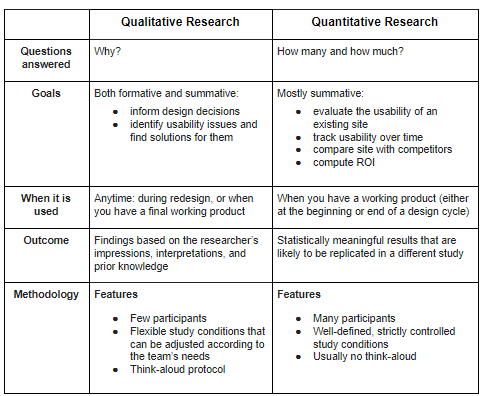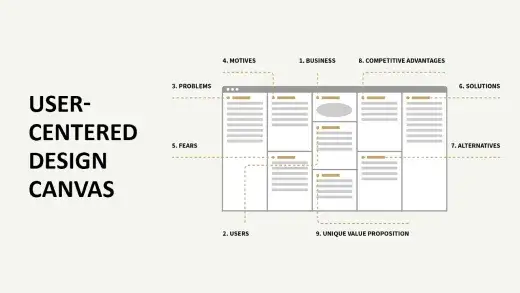Qualitative and Quantitative Research

Qualitative and Quantitative Research
Introduction
Marc Steen, a research scientist, says: “Research in design is highly contextual and a key principle of a human centered design process by involving users in one or many parts of the design process.” The purpose of the research is to understand people’s actions, needs and behaviors, to gain a deeper understanding of the problems, and receive valuable insights for the next design decisions. There are 2 types of research methods: Quantitative research and Qualitative research.
Qualitative research
Qualitative research is conducted through observation and collecting non-numerical insights such as emotions, human behavior, and subjective matters. The results of qualitative research are qualitative data, which consists of observational findings that identify design features easy or hard to use.
In qualitative research, UI elements will be listed for participants to evaluate, the observation output will help designers understand what aspects of the design are problematic or works well. Through the experience of participants, the designers will determine whether the corresponding UI element is actually poorly designed or not.
Methods for Qualitative Research
- Heuristic analysis
- Surveys
- Focus groups
- Personal Interviews
- Observation
- User testing (qualitative feedback)
What are the benefits of Qualitative Research?
- Customer validation: usability testing, focus group and brainstorming activities point out the ‘wants and needs’ of target users to generate the desired functions of your web/ application.
- Clarity: UX professionals gauge, analyse and obtain a lucid comprehension of the product's vision via a set of stakeholder interviews. The vision, key findings, personas, desired features and project’s objectives can be inferred from Qualitative UX Research.
Quantitative research
On the other hand, Quantitative Research is a systematic way of collecting and analyzing data from different sources by using computational, statistical, and mathematical tools.
The quantitative data offers an indirect assessment of the usability of design. Many quantitative studies are used to compare the usability with a known standard or with competitors' usability or previous design. Although quantitative data can tell us that our design may not be usable relative to a reference point, they do not point out what problems users encountered and what changes need to be made.
Methods for Quantitative Research
- Technical analysis
- Digital analytics
- Mouse tracking
- User testing (quantitative feedback)
What are the benefits of Quantitative Research?
- Identify site issues that negatively impact the user experience and find out the most important action user can take on your site
- Comparison between user testing results and the standard, figure out elements that visitors think are links but cannot be clicked
The difference between quantitative and qualitative research
Both qualitative and quantitative testing are essential in the UX/UI design. The difference between 2 methods that are shown in the table below may help researchers to select the suitable research types:

Source: https://www.nngroup.com/articles/quant-vs-qual/
Conclusion
Qualitative and quantitative research are complementary methods to gather user insights. Qualitative testing directly identifies the main usability problems in an interface. It is often used formatively, to inform the design process and channel it in the right direction. Quantitative research offers an indirect, summative evaluation of the site usability through metrics such as task-completion rate, task time, or satisfaction ratings. UX Researcher should choose the right and appropriate method to apply in the project based on its characteristics.
References
https://econsultancy.com/the-top-three-benefits-of-qualitative-research-in-ux/
https://www.nngroup.com/articles/quant-research-practice/
https://www.hotjar.com/blog/qualitative-vs-quantitative-user-research
https://econsultancy.com/the-top-three-benefits-of-qualitative-research-in-ux/
https://usabilitygeek.com/benefits-of-merging-quantitative-and-qualitative-data-in-ux-studies/
https://www.snapsurveys.com/blog/qualitative-vs-quantitative-research/
https://medium.com/digital-experience-design/an-overview-to-qualitative-and-quantitative-research-methods-in-design-de034a92f45c


